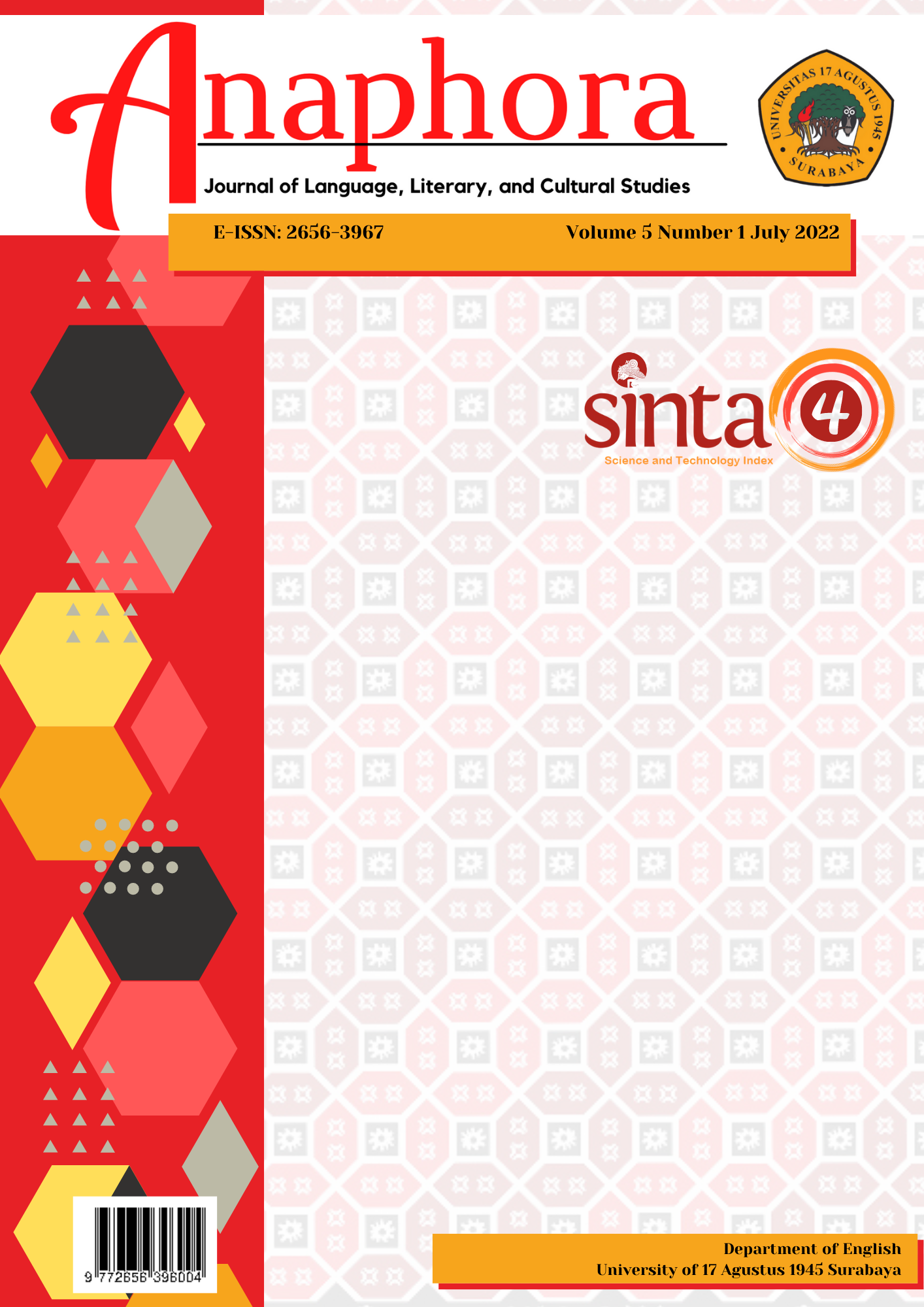Gender Intervention Through Toxic Masculinity in Hashimi's The Pearl That Broke Its Shell
Abstract
This article is about the idea of gender intervention through toxic masculinity reflected in Nadia Hashimi’s The Pearl That Broke Its Shell based on the theory of toxic masculinity by Terry A. Kupers. Beginning from a position that sees masculinity as a socially constructed idea in a patriarchal culture, this article works through the concept that hegemonic masculinity under patriarchy can turn toxic. There is a connection between toxic masculinity and hegemonic masculinity because toxic masculinity deviates from hegemonic masculinity aspects that are destructive. Many toxic masculinity traits can be found in society. This research uses a descriptive qualitative research design since this study will be limited to explain on two traits that are found in the novel. The most prominent traits that can be found in the novel are the subordination of women and violence. The idea of subordination of women can harm women because it puts them in an inferior position. This idea is also harmful to men as well when they could not meet society’s expectation of being “real” men. Toxic masculinity also has the belief that to prove their manhood, men have to be able to act violently. From that idea, some characters in the novel perform violence because they want to fit society’s expectation of being a “real” man. This study concludes that the hegemony of masculinity under a patriarchal society can result in a bad situation where men are viewed as superior and women as inferior. It can push the idea of toxic masculinity, which is harmful to both men and women. It is because men's superior position in this situation can be destructive and harmful for both men and women.
Downloads
References
Brooks, H. (2019). Toxic Masculinity and Queerness in Jane Eyre and Emma. San Marcos: Texas State University.
Creswell, J. W. (2014). Research Design: Qualitative, Quantitative and Mixed Methods Approaches (4th ed.). Thousand Oaks, CA: Sage.
Connell,R.W. & Messerschmith, J.W.(2005). Hegemonic Masculinity: Rethinking the Concept. Gender and Society, Vol.19, No.6, 829-859.
Gay, L. R., Mills, G. E., & Airasian, P. W. (2000). Educational Research. New Jersey: Pearson.
Haider, S. (2016). The Shooting in Orlando, Terrorism or Toxic Masculinity (or Both ?), Men and Masculinities, Vol. 19 (5), 555-565.
Hashimi, N. (2014). The Pearl That Broke Its Shell. New York: Harper Collins.
Hearn, J. (2004). From Hegemonic Masculinity to the Hegemony of Men. Feminist Theory, 5(1), 49–72. https://doi.org/10.1177/1464700104040813
Horlacher, S. (2015). Configuring Masculinity in Theory and Literary Practice. Boston: BRILL.
Istikomah, N. (2015). Women’s Attitudes towards Gender Discrimination in Khaled Hosseini’s A Thousand Splendid Suns. Yogyakarta: Yogyakarta State University.
Jewkes, R., Morrell, R., Hearn, J., Lundqvist, E., Blackbeard, D., Lindegger, G., Quayle, M., Sikweyiya, Y., & Gottzén, L. (2015). Hegemonic masculinity: combining theory and practice in gender interventions. Culture, Health and Sexuality, 17, 112–127. https://doi.org/10.1080/13691058.2015.1085094
Kupers, T. (2005). Toxic Masculinity as a Barrier to Mental Health Treatment in Prison. Journal of clinical psychology, 61.13-24. https://doi.org/10.1002/jclp.20105
Nilsson, B., & Lundgren, A. S. (2020). The #MeToo movement: Men and masculinity in Swedish News Media. The Journal of Men’s Studies, 29(1), 8–25. https://doi.org/10.1177/1060826520913613
Nurhadi, M. (2018). Tipologi Maskulinitas Dalam Cerita Karya Penulis Anak Indonesia Seri Kecil-Kecil Punya Karya. PARAFRASE: Jurnal Kajian Kebahasaan & Kesastraan, 18(01). https://doi.org/10.30996/parafrase.v18i01.1379
Singh, S. (2021). Patriarchy-a tool for men-women subjugation-an analysis of bell hooks’ ’understanding patriarchy. International Journal of Applied Research, 7(3), 138–140. https://doi.org/10.22271/allresearch.2021.v7.i3c.8383
Wellek, R & Warren, A. (1977). Theory of Literature. San Diego: Harcourt Brace Jovanovich.
Copyright (c) 2022 Anaphora: Journal of Language, Literary, and Cultural Studies

This work is licensed under a Creative Commons Attribution-ShareAlike 4.0 International License.
Authors whose manuscript is published will approve the following provisions:
-
The right to publication of all journal material published on the jurnal anaphora website is held by the editorial board with the author's knowledge (moral rights remain the property of the author).
-
The formal legal provisions for access to digital articles of this electronic journal are subject to the terms of the Creative Commons Attribution-ShareAlike (CC BY-SA) license, which means Jurnal Persona reserves the right to store, modify the format, administer in database, maintain and publish articles without requesting permission from the Author as long as it keeps the Author's name as the owner of Copyright.
-
Printed and electronic published manuscripts are open access for educational, research and library purposes. In addition to these objectives, the editorial board shall not be liable for violations of copyright law.




